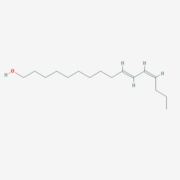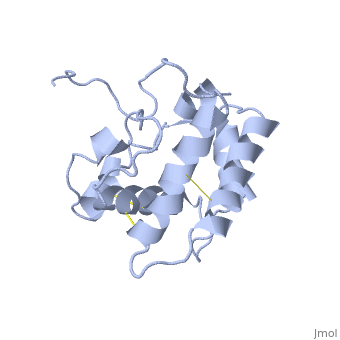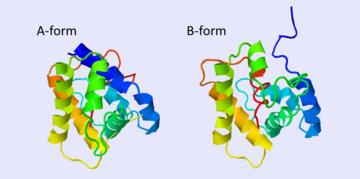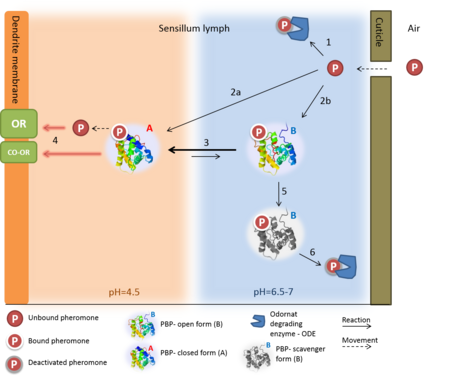Odorant binding protein
From Proteopedia
| Line 51: | Line 51: | ||
'''Conformation transition mechanism:''' | '''Conformation transition mechanism:''' | ||
The c-terminus of the protein bears mostly nonpolar amino acids. Yet on the surface of the helix there are three exceptional amino acids: Asp-132, Glu-137, and Glu-141, which are conserved in moth PBP <ref>doi: 10.1016/j.bbrc.2005.07.176</ref>. Of these, residues <scene name='68/683383/Bombykol_ligand_in_2p71/2'>Asp-132</scene> (and Glu-141, if present) triggers the formation of the alpha-helix upon protonation at low pH. This causes the ejacullation of the ligand from the binding pocket, which is replaced by the formated alpha helix<ref>doi: 10.1016/j.bbrc</ref>. | The c-terminus of the protein bears mostly nonpolar amino acids. Yet on the surface of the helix there are three exceptional amino acids: Asp-132, Glu-137, and Glu-141, which are conserved in moth PBP <ref>doi: 10.1016/j.bbrc.2005.07.176</ref>. Of these, residues <scene name='68/683383/Bombykol_ligand_in_2p71/2'>Asp-132</scene> (and Glu-141, if present) triggers the formation of the alpha-helix upon protonation at low pH. This causes the ejacullation of the ligand from the binding pocket, which is replaced by the formated alpha helix<ref>doi: 10.1016/j.bbrc</ref>. | ||
| - | |||
| - | |||
| - | <scene name='68/683383/Bombykol/3'>A form, with ligand</scene> | ||
| - | |||
Studies on other Lepidopterans that show a simmilar pH dependent conforamation suggests that this model is a genral model moth PBP<ref name="Leal" />. | Studies on other Lepidopterans that show a simmilar pH dependent conforamation suggests that this model is a genral model moth PBP<ref name="Leal" />. | ||
| Line 72: | Line 68: | ||
</StructureSection> | </StructureSection> | ||
| - | |||
| - | |||
== See also == | == See also == | ||
Revision as of 13:59, 11 January 2015
Contents |
Introduction
Odorant-binding protein (OBP) are soluble proteins which involve in the processes of odorant detection in the olfactory sensilla.
The first OBP that was identified is Bovine odorant binding protein, that was isolated from a cow's mucus ref. Though functunaly same, vertebrates and insects OBP have different origin and stucture. OBPs are important for insect olfaction. For instance, OBP76a (LUSH) in the fly Drosophila melanogaster is required for the detection of the pheromone vaccenyl acetate [Ha and Smith, 2006; Xu et al., 2005] and has been proven to adopt a conformation that activates the odorant receptor [Laughlin et al., 2008].

OBP in insects
OBP Function
Despite five decades of intensive research, the exact roles of OBP and the mechanism by which the odorant receptor (OR) is activated are still in dispute [1][2].
A few functions have been suggested for OBP: 1. Solubelizing the odorant molecule and its transportation in the sensillar lymph.
2. Protecting the odorant molecule from the odorant degrading enzymes, in the sensillar lymph.
3. Activating of the odorant receptor on the dendrite membrane, by the odorant-OBP complex.
4. Mediating the deactivation of the odorant molecule after the activation of the receptor.
5. An organic anion (the protein has 9 negative charges).
Of all, the first role of OBP as an odorant solubilizer and carrier is generally accepted.
In order to explain the structure and function of these fascinating proteins, this page will further focus on a particular OBP - the well investigated Bombyx mori PBP: BmorPBP.
Bombyx mori BmorPBP (lets talk about sex..)
| |||||||||||
See also
References
Proteopedia Page Contributors and Editors (what is this?)
Nurit Eliash, Michal Harel, Joel L. Sussman, Alexander Berchansky, Jaime Prilusky



